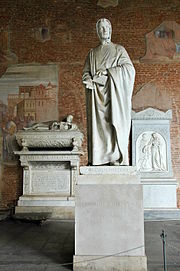Fibonacci
Fibonacci | |
|---|---|
| Nationality | Italian |
| Known for | Fibonacci number Fibonacci prime Brahmagupta–Fibonacci identity Fibonacci polynomials Fibonacci pseudoprime Fibonacci word Reciprocal Fibonacci constant Introduction of digital notation to Europe Pisano period Practical number |
| Scientific career | |
| Fields | Mathematician |

Leonardo Pisano Bogollo, (c. 1170 – c. 1250)[1] also known as Leonardo of Pisa, Leonardo Pisano, Leonardo Bonacci, Leonardo Fibonacci, or, most commonly, simply Fibonacci, was an Italian mathematician, considered by some "the most talented western mathematician of the Middle Ages."[2]
Fibonacci is best known to the modern world for:[3]
- The spreading of the Hindu-Arabic numeral system in Europe, primarily through the publication in the early 13th century of his Book of Calculation, the Liber Abaci.
- A number sequence named after him known as the Fibonacci numbers, which he did not discover but used as an example in the Liber Abaci.[4]
Liber Abaci
In the Liber Abaci (1202), Fibonacci introduces the so-called modus Indorum (method of the Indians), today known as Arabic numerals (Sigler 2003; Grimm 1973). The book advocated numeration with the digits 0–9 and place value. The book showed the practical importance of the new numeral system, using lattice multiplication and Egyptian fractions, by applying it to commercial bookkeeping, conversion of weights and measures, the calculation of interest, money-changing, and other applications. The book was well received throughout educated Europe and had a profound impact on European thought.
Liber Abaci also posed, and solved, a problem involving the growth of a population of rabbits based on idealized assumptions. The solution, generation by generation, was a sequence of numbers later known as Fibonacci numbers. The number sequence was known to Indian mathematicians as early as the 6th century, but it was Fibonacci's Liber Abaci that introduced it to the West.
Fibonacci sequence
In the Fibonacci sequence of numbers, each number is the sum of the previous two numbers, starting with 0 and 1. Thus the sequence begins 0, 1, 1, 2, 3, 5, 8, 13, 21, 34, 55, 89, 144, 233, 377, 610 etc.
The higher up in the sequence, the closer two consecutive "Fibonacci numbers" of the sequence divided by each other will approach the golden ratio (approximately 1 : 1.618 or 0.618 : 1).
The golden ratio was used widely in the Renaissance in paintings.
In popular culture
- Fibonacci's name was adopted by a Los Angeles-based art rock group, The Fibonaccis, that recorded from 1981 to 1987.
- Stock traders frequently look to the "Fibonacci retracement" when predicting future share prices.
- A youthful Fibonacci is one of the main characters in the novel Crusade in Jeans (1973). He was left out of the 2006 movie version, however.
- In The Da Vinci Code, the Fibonacci sequence was used as a code but also confused the characters.
Books written by Fibonacci
- Liber Abaci (1202), a book on calculations (English translation by Laurence Sigler, Springer, 2002)
- Practica Geometriae (1220), a compendium on geometry and trigonometry.
- Flos (1225), solutions to problems posed by Johannes of Palermo
- Liber quadratorum, ("The Book of Squares") on Diophantine equations, dedicated to Emperor Frederick II. See in particular the Brahmagupta–Fibonacci identity.
- Di minor guisa (on commercial arithmetic; lost)
- Commentary on Book X of Euclid's Elements (lost)
See also
- List of topics named after Fibonacci
- Brahmagupta–Fibonacci identity
- Elliott wave principle
- Engel expansion
- Fibonacci search technique
- Golden ratio
- Hylomorphism (computer science)
- Pisano period
- Practical number
- Primefree sequence
- Verner Emil Hoggatt, Jr.
Notes
- ^ http://library.thinkquest.org/27890/biographies1.html
- ^ Howard Eves. An Introduction to the History of Mathematics. Brooks Cole, 1990: ISBN 0-03-029558-0 (6th ed.), p 261.
- ^ Leonardo Pisano - page 3: "Contributions to number theory". Encyclopædia Britannica Online, 2006. Accessed 18 September 2006.
- ^ Parmanand Singh. "Acharya Hemachandra and the (so called) Fibonacci Numbers". Math. Ed. Siwan , 20(1):28-30, 1986. ISSN 0047-6269]
References
- Goetzmann, William N. and Rouwenhorst, K.Geert, The Origins of Value: The Financial Innovations That Created Modern Capital Markets (2005, Oxford University Press Inc, USA), ISBN 0195175719.
- Grimm, R. E., "The Autobiography of Leonardo Pisano", Fibonacci Quarterly, Vol. 11, No. 1, February 1973, pp. 99-104.
- A. F. Horadam, "Eight hundred years young," The Australian Mathematics Teacher 31 (1975) 123-134.
External links
- Fibonacci Biography
- Who was Fibonacci? by Ron Knott.
- Goetzmann, William N., Fibonacci and the Financial Revolution (October 23, 2003), Yale School of Management International Center for Finance Working Paper No. 03-28 [1]
- Fibonacci at Convergence
- wallstreetcosmos.com, Fibonacci numbers and stock market analysis, (2008).
- O'Connor, John J and Robertson, Edmund F. "Leonardo Pisano Fibonacci – 1170 - 1250" in The MacTutor History of Mathematics archive. University of St Andrews website, Scotland, 1998.
- Liber Abaci and its Egyptian fraction methods
- http://en.wikipedia.org/wiki/Liber_Abaci Liber Abaci on Wikipedia
